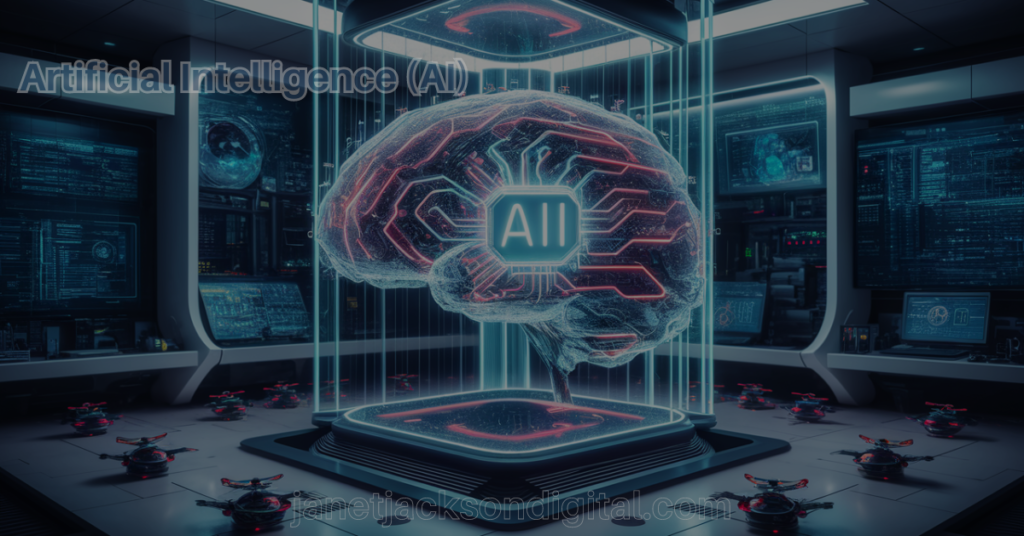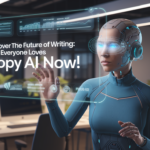Last Updated on June 11, 2024 by janetjacksondigital

With good reason, artificial intelligence (AI) content is one of the newest buzzwords in technology.
According to experts, artificial intelligence is a factor of production that has the potential to transform work methods in several industries and create new opportunities for expansion. For instance, this PWC analysis estimates that by 2035, artificial intelligence (AI) could increase global GDP by $15.7 trillion. Given that they will account for about 70% of the worldwide impact of the upcoming AI boom, China and the US stand to benefit the most.
Artificial Intelligence: What is it?
Artificial Intelligence (AI) is the simulation of human intellect in computers designed to have human-like thought and behavior.
The goal of artificial intelligence is to enable software, robots under computer control, or computers themselves to think intelligently like human minds. Artificial Intelligence can be attained by studying cognitive functions and patterns in the human brain. The results of these investigations involve the development of software and intelligent systems.
Strong AI vs. Weak AI
It is customary to divide artificial intelligence (AI) into two major categories: weak AI and strong AI. Let’s look at each kind’s characteristics:
- Weak AI, often known as narrow AI
Weak AI systems are artificial intelligence systems that are limited to completing specific tasks. Certain AI systems are very good at the tasks they are given, even when they lack general intelligence. Voice assistants such as Alexa or Siri, recommendation algorithms, and image recognition systems are a few instances of weak AI.
- Robust AI (general artificial intelligence)
Artificial intelligence (AI) systems that are as intelligent as humans or even more intelligent than humans in a range of tasks are referred to as strong artificial intelligence (AI), commonly known as general AI. Robust artificial intelligence would have the capacity to understand, reason, acquire new skills, and apply knowledge to resolve complex issues, much like human cognition. But as of now, the construction of powerful AI remains mostly theoretical and unattainable.
Read also : 8 Best AI Tools For Work In 2024, According To ResearchArtificial Intelligence Types
The several varieties of AI are listed below:
1. Exclusively Reactive
These devices have no memory or data and are only capable of doing one type of task. For instance, the computer watches moves in a chess game and determines which move is optimal to win.
2. Dim Recollection
These gadgets continuously add to their memory while gathering previous data. Despite having a bad memory, they have enough experience or knowledge to make sensible choices. For example, using the location data collected, this computer might recommend a restaurant.
3. Mental Theory
This type of AI is socially interactive and has the ability to comprehend feelings and ideas. A machine based on this design is still unbuilt.
4. Reflective
Machines that are aware of themselves will someday be developed thanks to these new technology. They will be sentient, intelligent, and cognizant.
Deep Learning vs. Machine Learning
Let’s look at the differences between deep learning and machine learning:
Machine Learning
Developing models and techniques that enable computers to learn from data and make decisions or predictions without the need for explicit programming is the aim of machine learning. The following are essential features of machine learning:
- Feature Engineering: To help the algorithm produce correct predictions, machine learning specialists manually engineer or choose pertinent features from the input data.
- Supervised and Unsupervised Learning: There are two types of machine learning algorithms: supervised learning, which involves training models on labeled data with predetermined results, and unsupervised learning, which involves training algorithms to find patterns and structures in unlabeled data.
Depth Learning:
The creation of artificial neural networks with functionality and architecture based on the human brain is the focus of a subfield of machine learning known as “Deep Learning”. The following are essential features of deep learning:
- Automated Feature Extraction: Rather than requiring explicit feature engineering, deep learning systems may automatically extract pertinent features from unprocessed data.
- Deep Neural Networks: To learn intricate hierarchical data representations, deep learning makes use of neural networks with several layers of connected nodes, or neurons.
- High Performance: Deep learning has excelled in a number of domains, often surpassing traditional machine learning methods, including computer vision, natural language processing, and speech recognition.
What Is The Process of Artificial Intelligence?
To put it simply, AI systems combine sophisticated, iterative processing algorithms with big data sets. AI is able to learn from the features and patterns in the examined data thanks to this combination. After analyzing data for a while, an artificial intelligence system looks back and assesses its performance, using the results to learn more.
Methods for Putting AI to Use
Let’s examine the following approaches that clarify how we can use AI:
Robotic Learning
AI is capable of learning thanks to machine learning.
Comprehensive Instruction
Deep learning is a kind of machine learning that allows artificial intelligence to simulate the neural network of a human brain. It is able to interpret data by identifying trends, noise, and confusing elements.
Here, we used deep learning to separate the different types of photos. Using a technique known as feature extraction, the computer examines different aspects of photos to identify them. The computer divides each picture into groups according to its characteristics, such landscape, portrait, and so on.
Let’s see how deep learning functions.
The three primary layers of a neural network are shown in the picture above:
- Layer of Input
- Covered Layer
- Layer of Output
Layer of Input
The input layer contains the photos that we wish to separate. The image’s arrows are drawn onto each input layer dot individually. Each white dot in the yellow input layer corresponds to a single pixel in the picture.
Covered Layer
The hidden layers take care of all mathematical operations and feature extraction from our inputs. The orange-colored layers in the illustration above stand in for the concealed layers. In the concealed layer, the total weights add up. The following hidden layer receives these values.
Layer of Output
The output layer provides us with divided images. The layer will identify whether the image is a portrait or a landscape once it has added up all of the weights that are being sent in.
Example: Estimating the Cost of Air Travel
This forecast is dependent on a number of variables, such as:
- Airline
- Airport of origin
- airport of destination
- Date of departure
To train the computer, we start with some historical ticket pricing data. We talked about machines with memory when we studied the four different types of machines earlier.
Cognitive Skills in AI Programming: Learning, Reasoning, and Self-Correction
Artificial intelligence prioritizes three cognitive abilities: self-correction, reasoning, and learning. These abilities are present in the human brain to varying degrees. Within the AI framework, these are what we characterize as:
- Acquiring knowledge and the set of rules needed to put it to use are the processes of learning.
- Reasoning is the process of drawing firm or approximative conclusions from the information rules.
- Self-Correction: The ongoing effort of enhancing artificial intelligence systems to guarantee that they yield the most correct results.
Benefits and Drawbacks of AI
Like any other idea or invention, artificial intelligence has advantages and disadvantages. The advantages and disadvantages are briefly summarized here.
Pros
It lessens the likelihood of human error.
It is available because it never sleeps. 24 x 7
It can undertake repetitious jobs with ease since it is never bored.
It moves quickly.
Cons
The implementation is expensive.
It is unable to match human creativity.
Without a doubt, it will displace certain jobs, increasing unemployment.
Individuals may grow unduly dependent on it.
Let’s talk about the uses of artificial intelligence as we continue our discussion of what artificial intelligence is.
Artificial Intelligence Examples
Artificial intelligence (AI) has revolutionized a number of industries and enhanced user experiences, growing to be a necessary component of daily life. Here are some notable uses of artificial intelligence:
ChatGPT
A sophisticated language model called OpenAI’s ChatGPT can have conversations in natural language and generate responses that sound human. It can comprehend and produce meaningful language using deep learning techniques, which makes it helpful for chatbots, virtual assistants, and customer service.
Maps Google
Google Maps uses AI algorithms to deliver personalized recommendations, traffic updates, and real-time navigation. It can estimate arrival times, recommend the shortest routes, and even anticipate traffic bottlenecks by analyzing massive amounts of data, including past traffic patterns and user input.
Astute Assistants
Smart assistants like Google Assistant, Apple’s Siri, and Amazon’s Alexa understand voice instructions, answer questions, and do tasks using artificial intelligence (AI) technologies. These assistants employ machine learning techniques and natural language processing to understand human intent, locate relevant information, and carry out requests.
Frequently asked questions
FAQ
Why is artificial intelligence significant, and what does it mean?
The culmination of multiple technologies working together is artificial intelligence, which enables robots to observe, comprehend, act, and learn at human-like cognitive levels. The fact that there is no one definition of artificial intelligence (AI) may be the reason why different people seem to define it differently.
What Exactly Is an Ecommerce Website? All-Inclusive Guide for 2024
Boost Your Online Presence: Essential SEO & Web Development Tips!
Five Arguments in Favor of Hiring a Digital Marketing Firm

My name is Janet Jackson Seo and I work as a SEO Expert. I appreciate the process of developing an innovative approach and employing logic, particularly when it concerns future studies and SEO optimization. As an SEO expert I have known how to set up SEO campaigns fully and how to monitor their achievements.





